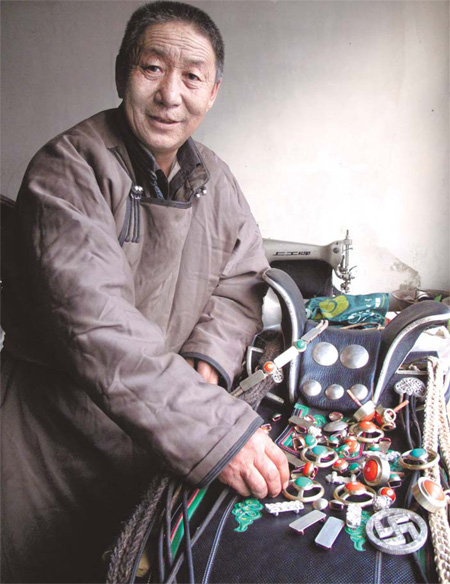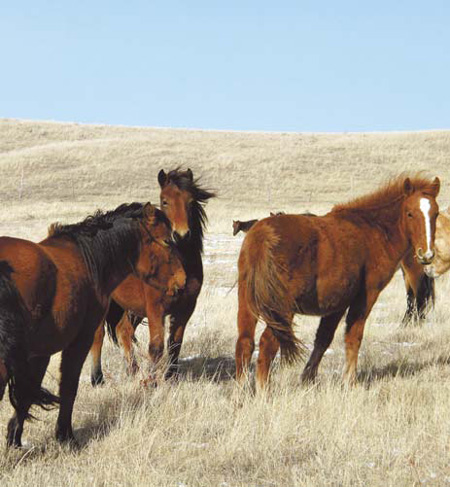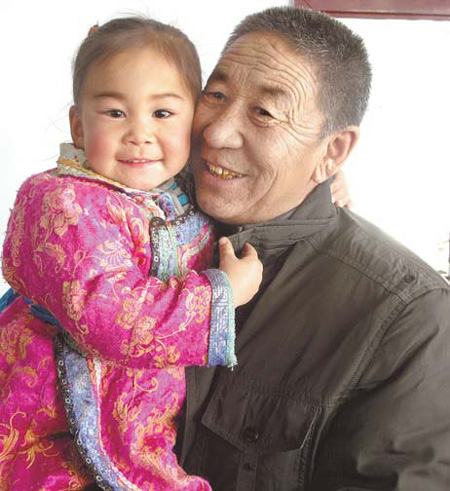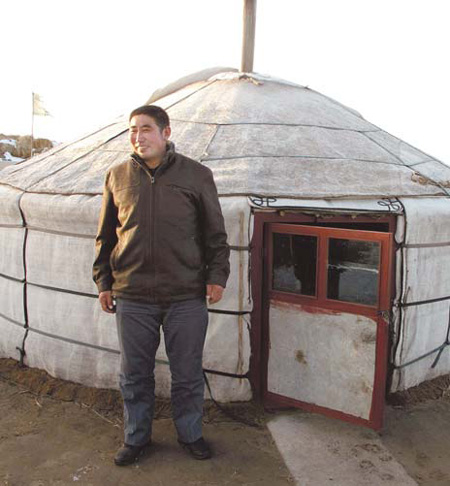Life and Leisure
Race against time
By Zhang Zixuan (China Daily)
Updated: 2010-12-06 07:34
 |
Large Medium Small |
|
Mongolian herder Altandelger hopes to pass on the traditional craft of saddle-making. Photos by Zhang Zixuan / China Daily |
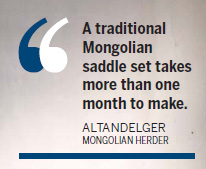
As the authorities step up efforts to save the grasslands from over-grazing, herders struggle to protect an abiding icon of their ethnic identity - the horse. Zhang Zixuan reports
Buyandalai, 48, a herder of Hexigten Banner, Inner Mongolia autonomous region, says he owes his life to his horse. But for its furious kicking to alert him to two wolves closing in on him on a full moon night in the open in 1985, he would never have been able to flee the scene in time. Buyandalai points out that Mongolians have been identified as "an ethnic group on horseback" since the time of Genghis Khan (1162-1227).
"The horse is a totem of the Mongolian people," he says, but laments that they are fast losing their iconic status.
Since the early 1980s when Inner Mongolia, along with the rest of the nation, introduced the system of farmland quotas, the traditionally nomadic herdsmen have become settlers. This has meant the grasslands are no longer grazed seasonally by rotation but intensely all-year round on the allotted lands.
"Horses only eat the grass tip so they need to move around. Free-range breeding allows grass sufficient time to grow, and this helps sustain the ecology," says Ortnastb, from the Inner Mongolia University in Hohhot, capital of the autonomous region. "When horses are fenced in, they die, and so do the steppes."
The sight of thousands of galloping horses, a common one at the time of Buyandalai's father is fast becoming the stuff of fairytales.
According to the Statistic Yearbook of Inner Mongolia, in 1975 there were 2.39 million horses in the autonomous region. That figure had fallen to 914,000 in 2002. And in 2010, there are less than 500,000 horses, decreasing constantly at the rate of 5.5 percent every year.
In 2003, the local steppe administrative bureau began to restrict the number of horses based on the yield of grass in the allotted grasslands. Horses that exceed the number attract a fine of 180 yuan ($27) each.
And in 2008, Buyandalai and other herders of Hexigten Banner were given notice that all large herds of horses in the banner would have to be sold within three years.
"Horses create little economic value and have lost their practical use as tools of transport and production," says Hobiskhaltu, deputy director of Hexigten Banner. "It's only a matter of time before they disappear."
But herders vehemently disagree. Oljei, a 62-year-old herder who sold all his 2,000 goats in 2002 in response to the call to protect the steppes says, "Unlike goats, horses don't destroy the grass roots. It's unfair to attribute the deterioration of the grasslands to horses."
He points out that much greater damage has been done by human exploitation through mining and tourism.
Altandelger, 60, who grew up on horseback, says horses are intelligent creatures who can warn herders about impending danger and foul weather.
"When they stop eating and move their ears, it means something dangerous is nearby," he says. "And if they keep on yawning, it indicates good weather the next day."
Living on the undulating Gungger steppe, Buyandalai still uses his horse as his means of transport, which he says is faster especially in winter.
But what he cares about much more is the cultural significance of the horse to his ethnic group.
"Mongolian culture is not just about singing songs and eating meat; it has got spirit," he says. "The Mongolian horse defines who we are."
The herder continues to own some 20 horses despite being fined more than 20,000 yuan ($3,000) between 2005 and 2009 by the local administration.
"The steppes can only support so much grazing and we have to consider the balance of the ecosystem," says Hobiskhaltu, the banner's deputy director. "We don't want to take the horses by force so fines offer the best deterrent."
To protect the Mongolians' horse culture, Buyandalai and Altandelger founded the Horse Culture Association in August 2009. Free to all herders, it received an enthusiastic response, with some 240 herder-families joining in with their more than 3,000 horses. The voluntary organization celebrated its foundation with a grand Nadam Fair, a traditional Mongolian event comprising activities such as horse racing and wrestling.
The one-day fair attracted some 6,000 participants and more than 300 horses and was finally extended to become a three-day event, the biggest such fair in Hexigten Banner after the "cultural revolution" (1966-76).
The two herders took another bold step, traveling to the south of Hexigten Banner thrice during August and September to buy 23 purebred iron hoof horses there.
Iron hoof horses from Hexigten have tremendous stamina. They played a significant role while Genghis Khan and his cavalry conquered the world. "But their numbers have fallen from more than 2,000 in the 1950s to only around 100 now," says Manglai, vice principal of Inner Mongolia Agricultural University and secretary general of China National Horse Industry Association.
Manglai says setting up a breeding base offers the best way to protect them.
"But iron hoof horses are not pandas as yet. Only when the authorities officially recognize them as endangered can such a base be realized," Hobiskhaltu says.
But Buyandalai and Altandelger were not prepared to wait. They pooled their resources of 10,000 yuan, borrowing another 60,000 yuan, to buy the 23 horses.
On Nov 8, Buyandalai received a notice from the local administration saying herders must sell all their horses before Nov 15. He was also asked to prepare his fine for 2010.
The herder is unfazed. "If a fine can let me keep my horses on the steppe, I'd rather pay it," Buyandalai says.
He is also determined, like Altandelger, to maintain his identity as a Mongolian herder.
Altandelger lives in downtown Hexigten and spends most of his time making horse saddles, a craft declared a provincial-level intangible cultural heritage in Inner Mongolia.
"A traditional Mongolian saddle set takes more than one month to make," Altandelger explains. "It begins with a wood base, which is then covered with sharkskin or leather. Other accessories such as stirrups and silver decorations are added later."
Although the horse is no longer the primary means of transport in the grasslands, making the saddle is an art that Altandelger wants to pass on.
Buyandalai, meanwhile, insists on living in a Mongolian yurt with his wife when other herders are replacing their traditional dwellings with brick houses.
He says there are less than 20 families in his banner who still live in yurts all year long like him.
|
The number of iron hoof horses in Hexigten Banner, Inner Mongolia, has fallen from more than 2,000 in the 1950s to about 100. |
|
Altandelger with his 4-year-old granddaughter. The 60-year-old Mongolian is determined to maintain his identity as a herder. |
|
Buyandalai and his family still live in a yurt while other herders have moved to brick houses. |
